DISCOVERING THE BEAUTIFUL PARC MONCEAU AND ITS ELEGANT NEIGHBOURHOOD
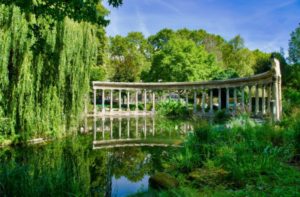
In the last two posts, we have looked at two outstanding Paris museums, relatively little-known to visitors, both located in the 8th arrondissement, one just around the corner from the other. They are both close by the Parc Monceau, one of the most interesting and beautiful parks in the city, at the junction of Bvd. de Courcelles, rue de Prony and rue Georges Berger. The neighbourhood is a quiet, discreetly elegant, mostly residential area with impressive mansions of the Haussmann or the neo-classical styles, typical of the Second Empire of Napoleon III. Covering about 8.20 hectares, Parc Monceau is a peaceful haven for locals, yet where comparatively few visitors visit.
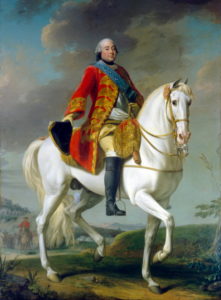
The construction of Parc Monceau dates back to the 17th century, under the orders of the Duc de Chartres, also known as Philippe d’Orléans, and cousin to Louis XVI. He was fabulously wealthy and well-connected, and in 1778, he transformed this expanse of open field into a bucolic park. With the help of artist Louis Carrogis Carmontelle, Philippe’s dream of a whimsical garden was realised.
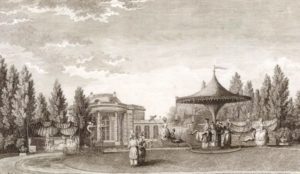
About his work, Carmontelle noted that “It is not necessary for gardens or nature to be presented in the most agreeable forms. It is necessary instead to preserve the charm that one encounters entering the garden and to renew it with each step so that the visitor in his soul will have the desire to revisit the garden every day and to possess it for himself. The true art is to know how to keep the visitors there, through a variety of objects, otherwise, they will go to the real countryside to find what should be found in this garden; the image of liberty.”
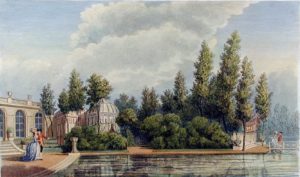
The Duc de Chartres, who was a close friend of England’s Prince of Wales (later George IV), was a lover of all things English. His intention was to create an English style garden, with architectural folies, or curiosities, dotted throughout the park to delight and surprise visitors—and the completed garden certainly delivered that: a miniature ancient Egyptian pyramid, a Roman colonnade, a water lily pond, a Tatar, or Turkish, tent, a Dutch windmill, a temple of Mars, an Italian vineyard, a farmhouse, a Chinese pagoda, a minaret, an enchanted grotto, ancient statues, and as Carmontelle described it, “a gothic building serving as a chemistry laboratory”. Some of these folies still exist today.
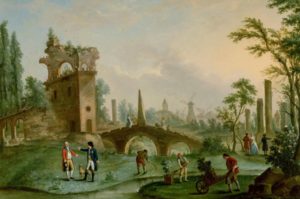
Though the folie was (and is) frequently described as an Anglo-Chinese or English garden, Carmontelle had a very different view. In his book Jardin de Monceau, près de Paris, published in 1779, he wrote that “It was not at all an English garden that was intended at Monceau, but precisely what the critics said: to put together into one garden all times and all places. It is simply a fantasy to have an extraordinary garden, a pure amusement…” To add to the atmosphere of the place, the Duc’s servants were dressed in oriental and other outlandish costumes, and exotic animals, such as camels were brought there.
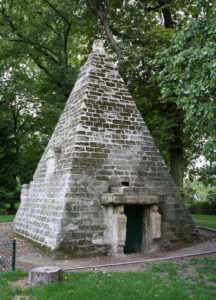
In 1783, Thomas Blaikie, a famous Scottish landscape gardener and designer of the Jardin de Bagatelle, transformed the exotic garden of Carmontelle, the “folies de Chartres”, into a magnificent, English-style garden where trees, lawns, and paths were designed to blend into the natural landscape.
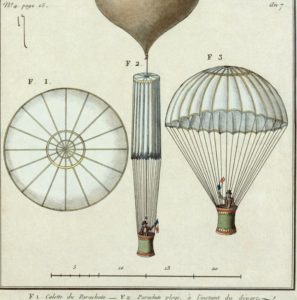
A fascinating little snippet of history is that in 1797, Parc Monceau was the site of the first silk parachute jump by André-Jacques Garnerin, who leapt from a Montgolfier hot air balloon, landing in the park where a large crowd was gathered.
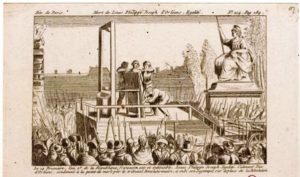
Philippe d’Orléans, was something of a free-thinker, a liberal, and a supporter of the ideas of the Revolution, which perhaps explains why he voted for the execution of his cousin the king. However, this did not prevent him falling foul of the revolutionaries, for, in 1793 he was himself guillotined. His landholdings, including Parc Monceau, were confiscated, but after the Napoleonic era, the park was restored to his family.

The size of the park was reduced from its original 20 hectares by more than half during the Second Empire as lots within the park were sold by the Duc’s family to real estate developers who built elegant mansions. The park now covers a little under 9 hectares, and its circumference is approx. 1.10 kms. Parc Monceau was purchased by the City of Paris in 1860 and was re-designed by Baron Haussmann, together with his engineer Jean-Charles Alphant and horticulturist Barillet-Deschamps, as part of his great urban works of Paris.
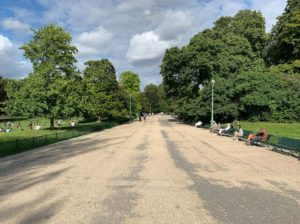
It re-opened in 1861 as the first new public park in Paris created by him. He had two main alleys laid out north to south, the Allée Ferdousi, and east to west—Allée de la Comtesse de Ségur—meeting in the centre of the garden. These Allées were made wide enough and paved to let carriages drive through the park.
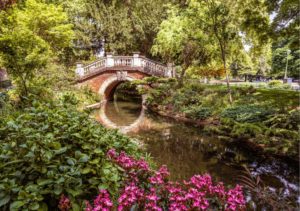
Baron Haussmann also planted several exotic trees and flowers from around the world as well as small footbridges over streams, winding paths, waterfalls, and a grotto to embellish Parc Monceau. Most of the original folies from the 18th century are now gone, except for the Egyptian pyramid, although Haussmann added a few structures, including statues as well as the exotic trees. The park features a rock topped by a beehive, and a small waterfall adds to the enchantment of the place. A few metres off Allée de la Comtesse de Ségur, architect Gabriel Davioud added a small bridge over the stream modelled after the Rialto bridge in Venice to replace the Chinese bridge by Carmontelle that had once been there.
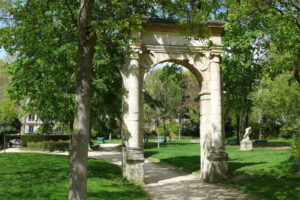
A little further on, the Renaissance arch is a relic from the city’s Hotel de Ville, which was burnt down during the Paris Commune of 1871. Nearby, the oval basin (la Naumachie) is bordered by a long Corinthian colonnade that once was part of a church in Saint-Denis which was dismantled in 1719.
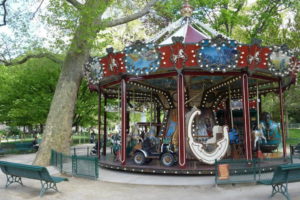
Today, the park caters very well to children with a play area, two sandpits, a carrousel, a sweets store, and a puppet show (Théâtre de marionettes). Essentially though, the park is the same as when Marcel Proust played and strolled through its leafy pathways—he lived practically next door at 45 rue de Courcelles.
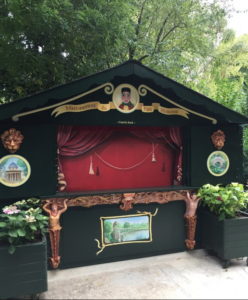
Following the downfall of Louis Napoleon, the Third Republic was declared on 04 September 1870, and from that time Parc Monceau was decorated with statues of eminent writers and musicians of the day.
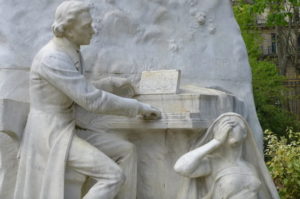
Today as you stroll along the park’s one km. perimeter pathway, stop to admire the statues that dot the path, from the monument to composer Charles Gounod, the bust of Alfred de Musset, a sculpture of Frederic Chopin at his piano, and statues of Ambroise Thomas, Guy de Maupassant and Edouard Pailleron.
The early days of the Third Republic were dominated by political disruptions caused by the Franco-Prussian War of 1870-71, which the Republic continued to wage after the fall of Emperor Napoleon III. The resulting social upheaval led to the establishment of the short-lived Paris Commune. In 1871, following the crushing of the ill-fated Commune, the Parc Monceau was the site of a massacre of Communards by army troops.
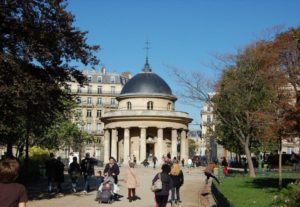
The main entrance into Parc Monceau is from the Courcelles Metro station on the northern edge of the park through a classic round Doric temple. This was originally known as the Pavilion de Chartres, designed by Claude-Nicolas Ledoux—today, generally referred to simply as the Rotunda. The ground floor was once used as a customs house when it was part of the taxation wall, known as the Wall of the Farmers-General (Mur des Fermiers Généraux) built in 1787, to surround Paris. The upper floor was a lavish apartment with a view of the garden, reserved for the Duc. The stately dome was added by architect Gabriel Davioud in the 19th century.

As this is a gated park, surrounded by a tall wrought iron fence, you will enter from one of the four entrances—Bvd. De Courcelles, Ave. Velasquez, Ave. Van Dyck, and Ave. Ruysdael. At the Avenue Van Dyck entrance there are magnificent gold-tipped wrought-iron gates in Louis Quinze style. Architect Gabriel Davioud designed each of the four park gates with the neighbourhood’s new wealth in mind, such as the bankers Pereire, the Rothschild, Cernuschi, Ménier and Camondo families.
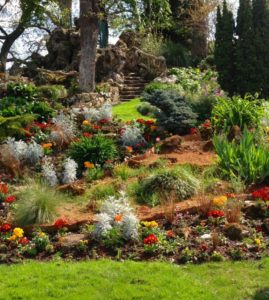
Davioud’s deft touch can be seen throughout Paris including the Saint-Michel Fountain, Theatre de Chatelet, and the Theatre de la Ville. In the late 19th century, Davioud was the chief architect of the City of Paris, when he also designed the Temple de la Sibylle and the main entryway at Parc des Buttes Chaumont. If you don’t know this terrific park—and it’s not on the usual tourist route—have a look at a blog from a couple of years ago: https://parisplusplus.com/paris/a-little-known-gem-parc-des-buttes-chaumont-2/
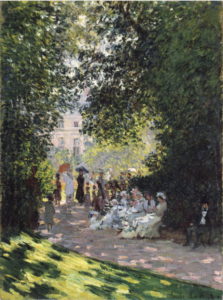
Impressionist painter Claude Monet loved the Parc Monceau and painted 3 views of it in the spring of 1876, one of which was exhibited at the Impressionist exhibition of 1877. He painted 3 further paintings of the park in 1878. Another Impressionist master, Gustave Caillebotte, also installed his easel in the park to capture the light and fleeting moments, and as well, photographers like Eugène Atget and Willy Ronis found the park inspirational.

On 20 June 1889, on the occasion of the World’s Fair where most of the attention was focussed on the Eiffel Tower, a big party was organised inside the Parc Monceau on the theme of the “One Thousand and One Nights” tale. A total of 30,000 reservations were made and 50,000 curious people gathered behind the wrought-iron gates.

Parc Monceau is also the guardian of the city’s biggest tree: an oriental plane tree which measures 7 metres in diameter at just 1 metre from the ground. As well as a large range of animals and plants, the park attracts a large diversity of birds, attracted by the heights of trees and the freshness of the pool filled with carp and goldfish.
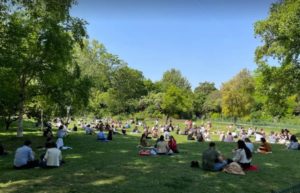
Head to the beautiful Parc Monceau when you’re in need of a break from the pace and activities of the city to refresh your senses and recharge your travel batteries. It’s open every day from sunrise to sunset, with extended hours in the summer months.
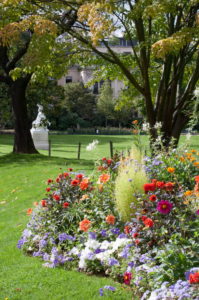


What a beautiful spot to wander through.
Hi Nadine,
We love this park! It’s such a restful place, as parks tend to be, but so many interesting little nooks and crannies, and some weird sights too, such as the pyramid and some of the sculptures, so it’s not “just a park”!
Cheers, Cheryl
What a beautiful Parc with such a interesting history so graphically told.
well done Cheryl. x Annette & Tony T
Hi Annette and Tony,
How lovely to receive your warm words, and I’m delighted you enjoyed the story. When are we going to have another catch-up at Frenchy’s?? We ae off to Italy and France again next Tues., and hopefully I’ll be inspired by some of our destinations to add some more blog stories!
Cheers for now, Cheryl (and Graham)
Hi Cheryl
I am new to your blog and so enjoy them!
Thank you
Julie Veron
Hi Julie,
Welcome to the Paris Plus Plus group! So delighted that you’re enjoying the stories, and do let me know if there’s a particular topic or destination you’d like me to explore, and I’ll certainly investigate it for you. Keep in touch!
Cheers,
Cheryl
I’ve just read about Parc Monceau and will definitely plan to visit next May, and combine it with the Camondo Museum and the beautiful homes in that area !! My maps ae being checked out !
Hi Lee,
Glad you enjoyed the story. Yes, Parc Monceau is lovely, and of course, the Musee Camondo is right on the doorstep. It’s a beautiful part of Paris that many visitors miss out on. I know you’ll love it!
Cheers, Cheryl